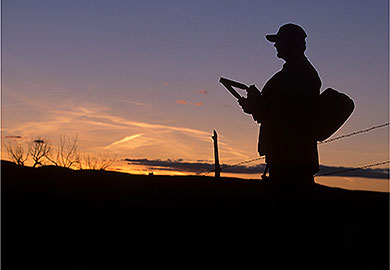DNR News
** Archived Article - please check for current information. **
March 20, 2014
Spring turkey season forecast fair, youth day March 29
An estimated 50,000 hunters will take to the woods during the upcoming turkey season, generating an estimated $30 million in direct expenditures for South Carolina’s economy. The 2014 wild turkey season begins April 1 on private lands in 34 counties that make up Game Zones 1-5 and for all Wildlife Management Areas statewide where turkey hunting is allowed. The season opened March 15 on private lands only in Game Zone 6: Allendale, Bamberg, Barnwell, Beaufort, Berkeley, Calhoun, Charleston, Colleton, Dorchester, Hampton, Jasper and Orangeburg counties. The season closes May 1 throughout the state.
Saturday, March 29 is Youth Turkey Hunt Day in areas where the season opens on April 1. On this day, youths 17 and under who are accompanied by a properly licensed adult (age 21 and older) may hunt turkeys. Only the youth can take or attempt to take turkeys. Tagging requirements remain in place for this special youth day.
The outlook for the 2014 spring season is only fair for most areas, according to Charles Ruth, Deer and Turkey Project supervisor for DNR. Annually since the early 1980’s, SCDNR conducts a Summer Turkey Survey to estimate reproduction and recruitment of turkeys in South Carolina. The survey involves agency wildlife biologists, technicians and conservation officers, as well as many volunteers from other natural resource agencies and the general public.
estimate reproduction and recruitment of turkeys in South Carolina. The survey involves agency wildlife biologists, technicians and conservation officers, as well as many volunteers from other natural resource agencies and the general public.
Although reproduction in turkeys has been somewhat better the last couple of years, indicators plummeted in 2013, said Ruth. Average brood size of 3.9 poults remained relatively consistent, however, the total recruitment ratio of 1.3 was down about 32 percent. Recruitment ratio is a measure of young entering the population based on the number of hens in the population. This figure was driven by a high percentage of hens (66%) that had no poults at all. Both recruitment ratio and percentage of hens with no poults were the lowest during 2013 since the survey began in 1982. “At the regional level it appears that reproduction was poor in most of the state.”
Unlike deer, wild turkeys are much more susceptible to significant fluctuations in reproduction and recruitment. Lack of reproductive success is often associated with bad weather (cold and wet) during nesting and brood rearing season and most of the state saw unprecedented rainfall that began late last spring and continued throughout most of the summer
What does poor reproduction in 2013 mean for the spring turkey hunter? Ruth indicated, “Spring harvest trends have followed the trends in reproduction in recent years. With reproduction way down during the summer of 2013, the outlook for the 2014 spring season is not terribly encouraging. One positive note, said Ruth, the gobbler to hen ratio remained good with a statewide average of 0.70, about average for the last few years.
Many experts believe that when gobbler to hen ratios get below 0.5, the quality of hunting can be impacted because hens are extremely available which affects gobbling and responsiveness to calling by hunters.
“The bottom line,” Ruth said, “the state’s turkey population remains about 25 percent below record levels of 10 years ago and we need better reproduction for several years to get the population back up. That is the nice thing about turkeys; given the right conditions they can naturally bounce back in a short period of time.
More News
- Spring turkey season forecast fair, youth day March 29
- Brushy ditch banks, weedy field borders are beneficial to wildlife around farms
- March Madness is underway for weather observation
- Boardwalk at Dungannon Plantation Heritage Preserve closed to protect nesting wood storks
- Boating Infrastructure Grant Workshop on April 22 in Charleston
- Lifetime Fishing License awarded for participation in Lower Saluda Trout Study
- 4.1 magnitude earthquake rattles Edgefield on Feb. 14
- Spring turkey hunters should order tags now for upcoming season
- Adult-youth fishing open at Bonneau Ferry
- DNR hosts series of youth fishing rodeos/family fishing clinics around the state
- Antler measuring sessions set across South Carolina
- 2nd Annual SCDNR Youth Bass Fishing Championship to be held on Lake Murray March 29
- Freshwater fishing trends
- Saltwater fishing trends
- S.C. weekly tidetable
- DNR video
- Archived news releases
